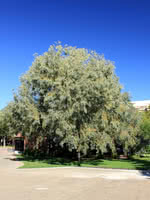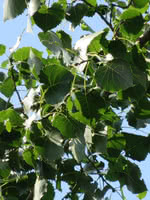Mon-Fri 9am - 5pm Mountain time
Golden Willow vs Eastern Cottonwood
Salix alba vitellina
Populus deltoides
NOT AVAILABLE THIS SEASON - MIGHT RETURN
Golden Willow is an attractive accent tree that's perfectly suited for those moist or wet areas on your property.
This fast growing tree has glossy narrow leaves that turn gold in fall, furrowed brown bark and showy gold branches that especially stand out in the winter.
Golden Willow is commonly used for windbreaks, shelterbelts, and ornamental planting. In addition to looking great, Golden Willow attracts a variety of birds and mammals with its twigs and buds.
All willow are important to native pollinators each spring as they have higher amounts of pollen and nectar early each growing season when other food sources are scarce.
Note: do not plant near buildings or buried services.
This fast and tall growing tree has an open, spreading crown and is more suited to waterside planting than other aspens and poplars.
Commonly found in floodplains, stream valleys and lake shores, this tree quickly fills in reclamation areas.
In order to reproduce and grow effectively, Eastern Cottonwood relies on the natural flooding cycle to ensure they are not out-competed by weeds and other plants.
Golden Willow Quick Facts
Eastern Cottonwood Quick Facts
In row spacing: 2.4 - 3 m (8 - 10 ft)

